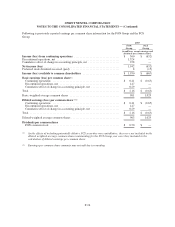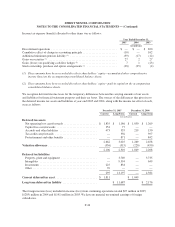Sprint - Nextel 2005 Annual Report Download - page 131
Download and view the complete annual report
Please find page 131 of the 2005 Sprint - Nextel annual report below. You can navigate through the pages in the report by either clicking on the pages listed below, or by using the keyword search tool below to find specific information within the annual report.SPRINT NEXTEL CORPORATION
NOTES TO THE CONSOLIDATED FINANCIAL STATEMENTS — (Continued)
Other Asset Impairments
In 2005, we incurred a $77 million asset impairment related to the write-off and removal from service of certain
internal-use software systems that are no longer being utilized by Local. We also incurred $19 million in asset
impairments related to hurricane damage, which were substantially recovered from insurance carriers. Also in
2005, we recorded $50 million in asset impairments related to the write-down of various software applications.
In 2004, we determined that business conditions and events occurring in 2004 and impacting our Long Distance
operations constituted a “triggering event” requiring an evaluation of the recoverability of the Long Distance
long-lived assets pursuant to SFAS No. 144, Accounting for the Impairment or Disposal of Long-Lived Assets.
The industry-wide business conditions and events included the continuing impacts of the highly-competitive
Long Distance market, the related aggressive pricing, recent changes in the regulatory climate negatively
impacting the long-term ability of Long Distance to bridge the last mile in the consumer and small business
market segments, product substitution and customers’ accelerated demands for cost-effective, advanced,
IP-driven telecommunications solutions requiring transparent wireline and wireless connectivity. In light of these
industry-wide business conditions and events, we reevaluated our strategy and financial forecasts in 2004.
Evaluations of asset recoverability are performed at the lowest asset or asset group level for which identifiable
cash flows are largely independent of the cash flows of other assets or asset groups. Due to the integrated nature
of the long distance network, we conducted our testing of the asset group at the Long Distance entity level
(excluding assets held for sale), as this is the lowest level for which identifiable cash flows are available. Further,
it was concluded that the fiber-optic backbone constituted the primary asset of the Long Distance asset group.
Accordingly, cash flows were projected over the remaining useful life of the fiber-optic backbone. These cash
flow projections reflect estimated future operating results, considering all relevant circumstances and events, and
estimated capital expenditures required to maintain, but not to increase, the service potential of the asset group.
The resulting undiscounted future cash flows were less than the carrying value of the Long Distance asset group,
requiring that the asset group be reduced to fair value.
The fair value of the asset group was determined by discounting the cash flow projections at a 10% discount rate,
reflecting a risk-adjusted weighted average cost of capital. The resulting fair value of the asset group required a
$3.52 billion pre-tax non-cash impairment charge, reducing the net carrying value of Long Distance property,
plant and equipment by about 60%, to $2.29 billion at September 30, 2004.
Also in 2004, we completed the sale of our wholesale Dial IP business for $34 million, resulting in a pre-tax
non-cash charge of $21 million.
In 2003, we recorded a pre-tax, non-cash charge of $1.2 billion related to the write-down in the carrying value of
our BRS spectrum. Our evaluation of our business use for this asset resulted in a decision to end pursuit of a
residential fixed wireless strategy. This decision required an impairment analysis of the asset. As a result of our
merger, we have increased our BRS spectrum holdings, and intend to use this spectrum in combination with other
spectrum holdings to offer wireless interactive multimedia services.
F-36
























